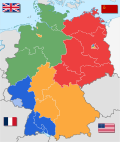Bizone: Difference between revisions
No edit summary |
Pianist ru (talk | contribs) |
||
| Line 21: | Line 21: | ||
*[http://www.usip.org/pubs/peaceworks/pwks49.html The Road Ahead: Lessons in Nation Building from Japan, Germany, and Afghanistan for Postwar Iraq, by Ray Salvatore Jennings] May 2003, Peaceworks No. 49, [[United States Institute of Peace]] |
*[http://www.usip.org/pubs/peaceworks/pwks49.html The Road Ahead: Lessons in Nation Building from Japan, Germany, and Afghanistan for Postwar Iraq, by Ray Salvatore Jennings] May 2003, Peaceworks No. 49, [[United States Institute of Peace]] |
||
* Lewkowicz, N., The German Question and the Origins of the Cold War (IPOC:Milan)(2008) |
* Lewkowicz, N., The German Question and the Origins of the Cold War (IPOC:Milan)(2008) |
||
{{Occupation zones in Germany}} |
|||
[[Category:West Germany]] |
[[Category:West Germany]] |
||
Revision as of 23:34, 25 June 2009

The Bizone, or Bizonia, was the combination of the American and the British occupation zones during the occupation of Germany after World War II. With the addition of the French occupation zone, the entity became the Trizone or Trizonia. In 1949, the trizone became the Federal Republic of Germany (commonly known as West Germany).
In 1946, the Soviet Union stopped delivering agricultural products from their sector in Eastern Germany to the more industrial western sectors and zones. In return, the American military administrator, Lucius D. Clay, ceased transferring supplies and dismantled factories from the Ruhr area to the Soviet sector. As a result of this, the Soviet Union started a public relations campaign against American policy and began to obstruct the administrative work of all four sectors.
The USA and the UK united their zones on 1 January 1947, creating Bizone, in order to advance the development of a new political order in Western Germany. Nevertheless, this was the first step that would eventually lead to the separation of Germany into East Germany and West Germany.
Lewkowicz argues that the establishment of Bizonia was the most significant factor in the creation of two blocs in Europe and therefore in the configuration of the Cold War international order.
British military deployments
United States military deployments
External links
- site of the modern version of Wir sind die Eingeborenen von Trizonesien (song used by the Trizone) in mp3
- The Road Ahead: Lessons in Nation Building from Japan, Germany, and Afghanistan for Postwar Iraq, by Ray Salvatore Jennings May 2003, Peaceworks No. 49, United States Institute of Peace
- Lewkowicz, N., The German Question and the Origins of the Cold War (IPOC:Milan)(2008)

